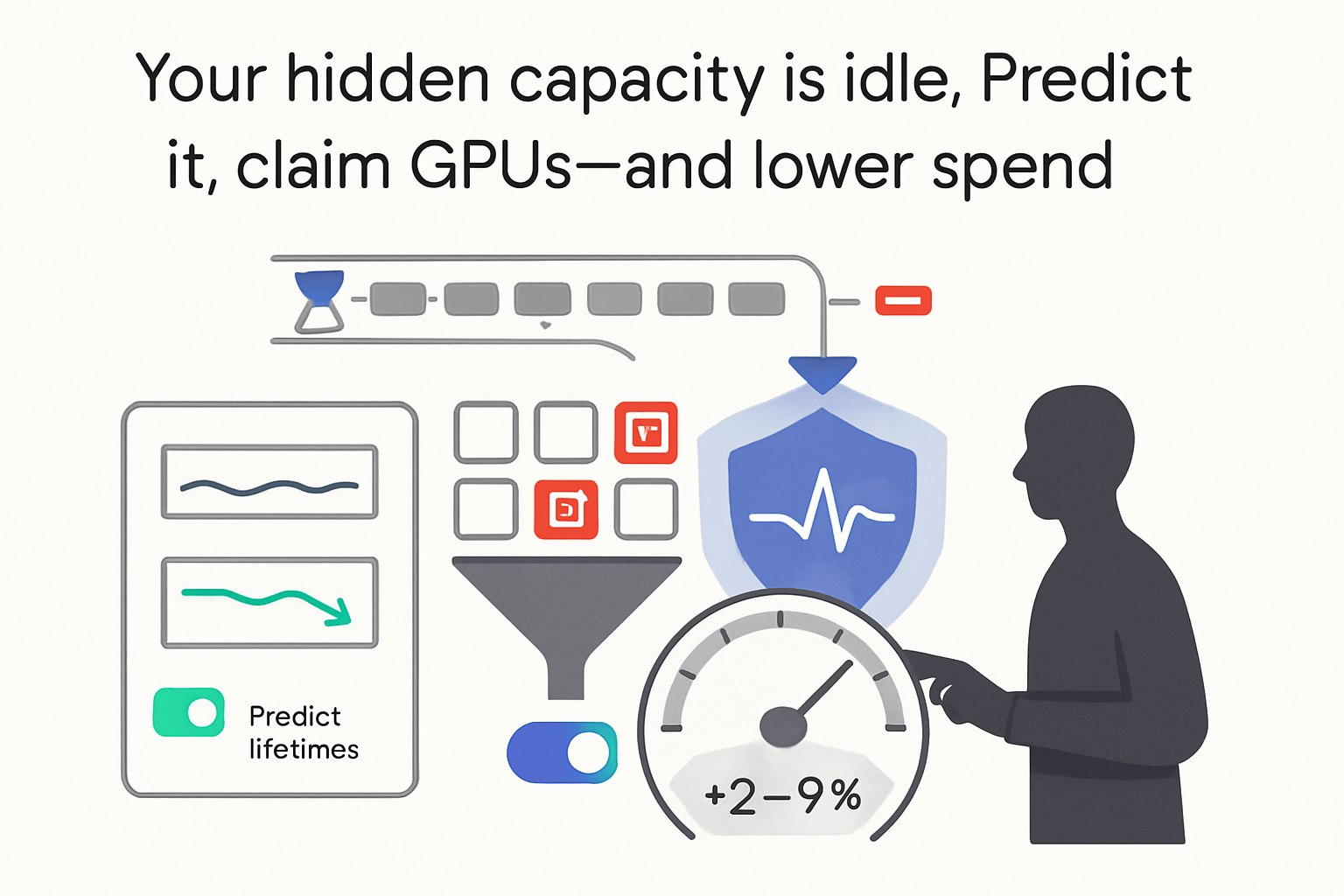Google Research and DeepMind announced lifetime-aware VM scheduling algorithms - NILAS, LAVA, and LARS - that predict and continuously update expected VM lifetimes to boost data-center efficiency. The marketer’s question: will this shift cloud capacity, reliability, and cost structures in ways that affect ad platforms, AI production, and analytics budgets over the next 12-24 months? Thesis: the reported 2-9% efficiency gains already in production via NILAS, with additional upside projected from LAVA and LARS, will likely improve compute availability and stability before they change prices. Plan for smoother access to large VMs and GPUs and modest unit-cost relief in select SKUs rather than direct CPC or CAC impacts.
How Google LAVA VM scheduling affects cloud capacity and marketing operations
Google’s lifetime-aware scheduling reframes the bin packing problem by repredicting VM lifetimes in real time and placing short-lived workloads alongside long-lived ones to reduce fragmentation. The practical result is more empty hosts for maintenance headroom and large-VM provisioning, and less stranded CPU and memory. For marketers, this points to better availability of heavy compute for model training and inference, creative rendering, and steadier service levels from martech vendors running on GCP - more supply and fewer interruptions rather than immediate price cuts. For methodology details, see LAVA: Lifetime-Aware VM Allocation with Learned Distributions and Adaptation to Mispredictions.
Key takeaways
This announcement signals meaningful backend changes rather than visible product pricing moves. The items below distill what matters for marketing and growth teams.
- Capacity and availability: Google reports a 2.3-9.2 percentage point increase in empty hosts in production from NILAS; 1 pp is roughly 1% capacity. Simulations suggest LAVA could add ~0.4 pp and LARS could cut maintenance migrations by ~4.5% [S1]. So what: expect easier access to large VMs and GPU nodes and faster job starts for data and AI work, especially in crowded regions, before any list-price moves.
- Reliability and maintenance windows: More empty hosts plus smarter rescheduling reduces defragmentation pain. So what: lower odds of service interruptions for ad tech and analytics vendors on GCP; fewer surprise pauses for ETL, training runs, or real-time pipelines that support bidding and personalization.
- Cost direction: Efficiency gains in the 2-10% range raise the probability of selective price-performance improvements or higher quotas over 6-18 months, depending on demand mix. So what: model flat-to-slightly-down unit costs for compute-heavy marketing workloads; prioritize contract terms that let you capture potential pass-through (for example, vendor price reviews and usage-based tiers).
- Ad auction impact: CPCs and CPMs are dominated by bidder competition, not serving costs. So what: do not expect direct CPC relief; instead, anticipate faster rollout and scaling of AI-driven ad features at stable price points due to lower backend friction.
Situation snapshot
Google Research and DeepMind detailed three algorithms - NILAS, LAVA, and LARS - that use probability distributions and continuous reprediction of VM lifetimes to improve placement, packing, and maintenance at data-center scale [S1][S2]. Concepts draw on survival analysis and bin packing.
Undisputed facts
- NILAS has run in production since early 2024 on Borg, increasing empty hosts by 2.3-9.2 pp and reducing CPU stranding by ~3% and memory stranding by ~2% in some pilots [S1].
- LAVA simulations suggest another ~0.4 pp improvement over NILAS; LARS simulations indicate ~4.5% fewer live migrations during maintenance [S1].
- The model is compiled into the Borg scheduler binary, avoiding a circular dependency on model servers; median inference latency is ~9 µs - about 780x faster than a separate model-serving setup [S1].
- VM lifetimes follow a long-tailed distribution: 88% run less than 1 hour but account for ~2% of resource consumption. Long-lived VMs dominate resource usage and schedule outcomes [S1].
- Technical framing uses bin packing and survival analysis to predict lifetime distributions and update expected remaining lifetimes over time [S1][S2][S3].
Breakdown and mechanics
The core logic aligns supply with time-aware demand to free whole machines and reduce waste.
- Problem shape: VM lifetimes are highly skewed; misplacing a few long-lived VMs blocks hosts and strands resources. Traditional single-shot lifetime guesses at VM creation are brittle.
- Model shift: Predict a distribution over lifetimes rather than a point estimate, then continuously repredict expected remaining lifetime as the VM keeps running via survival analysis. This updates the scheduler’s view of which hosts free up when.
- Algorithm tactics:
- NILAS: add a lifetime-aware score to existing host ranking, preferring hosts where VMs are predicted to finish around the same time - creating future empty hosts [S1].
- LAVA: place short-lived VMs into the gaps alongside long-lived VMs so they exit before extending host lifetime; adapt host lifetime if mispredictions persist [S1].
- LARS: for maintenance and defragmentation, migrate the longest-lived first, letting short jobs complete naturally - cutting total migrations ~4.5% in simulations [S1].
- System deployment:
- Compile the model into the scheduler to remove external serving dependencies and achieve microsecond latency - critical for frequent repredictions at fleet scale [S1].
- Cache host lifetime scores to avoid recomputation; update on VM add or remove, or when a host’s expected lifetime lapses [S1].
Cause-effect chain: Repredictions -> better host scoring -> tighter packing and aligned exit times -> more empty hosts plus less stranding -> easier maintenance and capacity headroom -> higher availability for large VMs and reduced disruptions.
Impact assessment
Near term, expect operational and capacity gains; pricing effects require vendor choices and demand context.
Paid Search and Ad Delivery
- Direction: Reliability improves; pricing unchanged.
- Why: Serving costs are a small component vs auction dynamics. Fewer maintenance-induced hiccups lower tail-latency risk in services that support ads.
- Actions: Monitor status pages and incident rates from ad and measurement vendors; no budget changes solely on this news.
Organic/Search/SEO Systems
- Direction: Negligible direct impact near term.
- Why: Google crawl and index policy is product-led, not constrained by marginal data-center headroom.
- Actions: None specific; avoid assuming crawl increases.
Cloud Cost and Data Engineering (GCP buyers)
- Direction: Availability and queue times improve; selective unit-cost relief possible if passed through.
- Magnitude: 2-10% effective capacity gain reported (NILAS) with a further ~0.4 pp upside in simulations (LAVA); maintenance overhead down ~4.5% (LARS) [S1].
- Beneficiaries: Large VM and GPU or TPU users; teams with mixed batch and interactive pipelines; regions with chronic capacity pressure.
- Actions: Track quota and availability for GPU and large VM families; consider flexible reservations; include price-review clauses with vendors tied to infrastructure efficiency improvements.
Creative and AI Production
- Direction: Easier scaling of generative pipelines; pricing steady for now.
- Why: More consistent access to compute; backend stability supports higher throughput.
- Actions: Pilot higher concurrency targets; re-benchmark turnaround times; plan for burst capacity in campaigns with intensive creative generation.
SaaS, Adtech, and Martech Vendors on GCP
- Direction: COGS tailwinds and fewer maintenance migrations; potential gross-margin gains.
- Losers: Workloads that benefited from fragmentation scarcity (speculative), for example niche spot-capacity arbitrage if preemption patterns change.
- Actions: Ask vendors about updated SLAs, latency SLOs, and any pass-through of efficiency to pricing or tiers.
Scenarios and probabilities
- Base (Likely): Efficiency is absorbed by demand growth; customers see better availability and stability; limited near-term price changes. Budget compute costs flat to slightly down for heavy jobs; plan for smoother quota access.
- Upside (Possible): Select GCP SKUs - for example, large VMs or GPU families or spot - gain measurable availability with modest price-performance improvements over 6-18 months as regions rebalance. Vendors pass through part of COGS gains in renewals.
- Downside (Edge): Gains are fully reinvested into new AI features and regional expansions with no pass-through; temporary pressure on spot or preemptible reliability during rollout transitions.
Note: Pricing outcomes depend on regional demand and product mix; auctions for ads remain demand-driven.
Risks, unknowns, limitations
- External validation: Results are internal to Google’s Borg; third-party benchmarks are not available. LAVA and LARS results are simulation-based, not yet production-wide [S1].
- Transferability: GCP customer-visible impact depends on service layers above Borg and regional load patterns; net effect may vary by zone and VM family.
- Pass-through rate: No commitment from Google on pricing or quota changes tied to these gains.
- Spot and preemptible dynamics: No published data on preemption-rate shifts; any claims here would be speculative.
- Falsifiers: Public data showing no change in quota or availability or rising preemption rates over time, or Google pricing updates unrelated to efficiency improvements.
Sources
- [S1]: Google Research, Oct 17, 2025, blog post, “Solving Virtual Machine Puzzles: How AI Is Optimizing Cloud Computing.”
- [S2]: Worah, Maas et al., 2024, arXiv preprint, “LAVA: Lifetime-Aware VM Allocation with Learned Distributions and Adaptation to Mispredictions.”
- [S3]: Verma et al., 2015, research paper, “Large-scale cluster management at Google with Borg.”
- [S4]: Wikipedia, reference article, “Bin packing problem.”
- [S5]: Wikipedia, reference article, “Survival analysis.”
Validation: This analysis states a thesis, explains mechanics, quantifies effects using published figures, contrasts short vs long-term outcomes, identifies likely winners and losers, and flags uncertainties. The action points focus on availability, reliability, and budgeting rather than speculative CPC changes.








.svg)